London School of Commerce Numeracy and Data Analysis Report
VerifiedAdded on 2023/01/17
|9
|1348
|56
Report
AI Summary
This report presents a comprehensive analysis of London's humidity data over a 10-day period, employing various data analysis techniques. The report begins with the arrangement of data in both table and chart formats, illustrating the trends in humidity levels. It then delves into the calculation o...
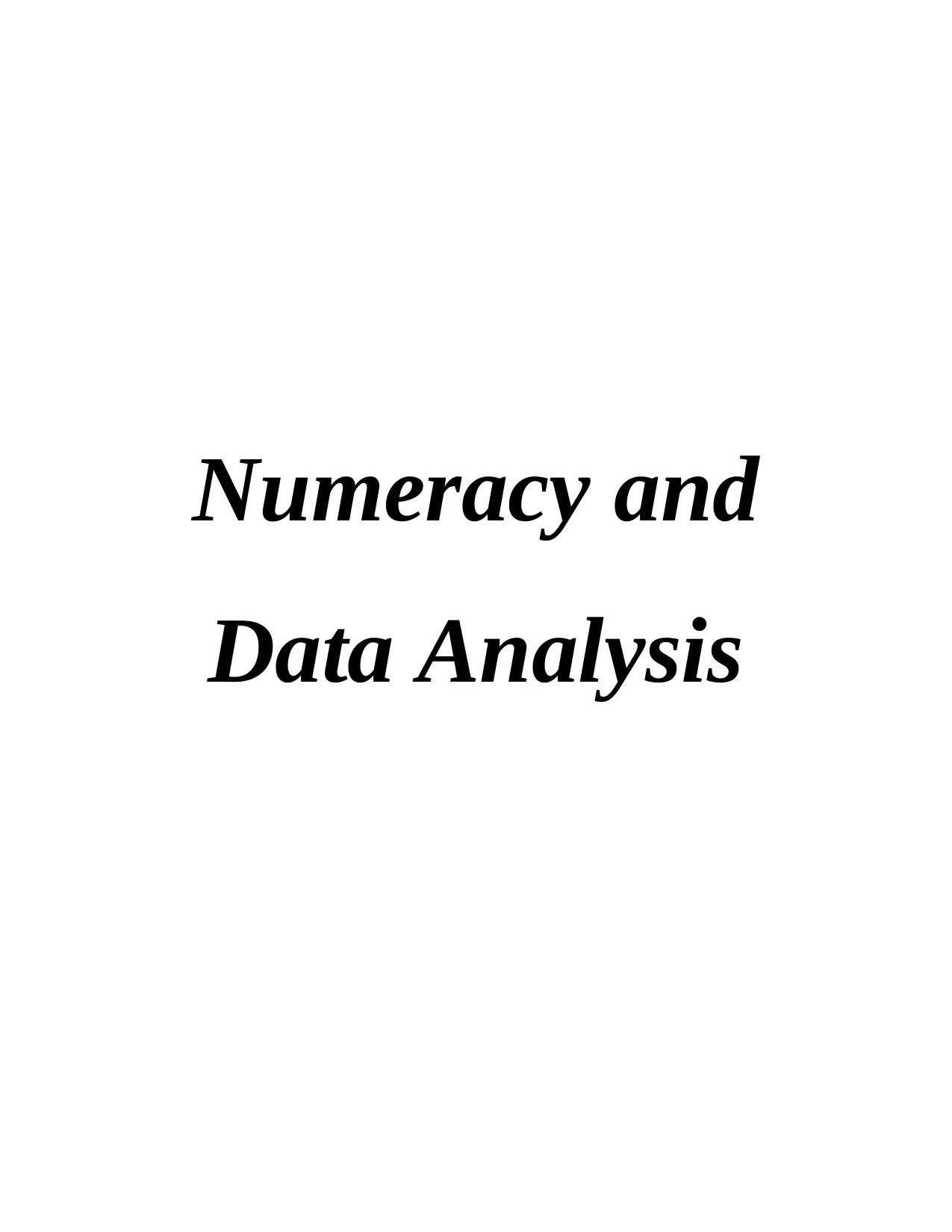
Numeracy and
Data Analysis
Data Analysis
Paraphrase This Document
Need a fresh take? Get an instant paraphrase of this document with our AI Paraphraser
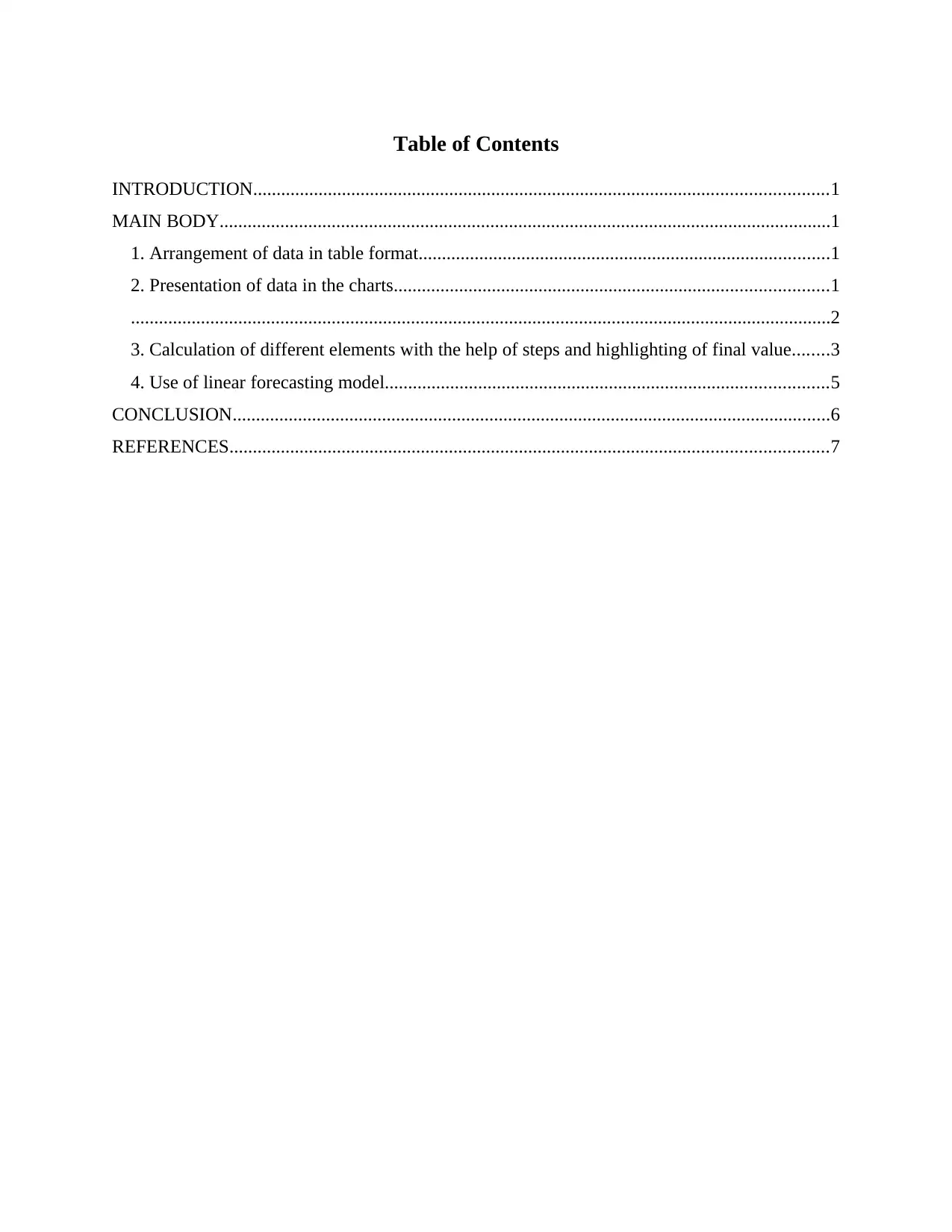
Table of Contents
INTRODUCTION...........................................................................................................................1
MAIN BODY...................................................................................................................................1
1. Arrangement of data in table format........................................................................................1
2. Presentation of data in the charts.............................................................................................1
......................................................................................................................................................2
3. Calculation of different elements with the help of steps and highlighting of final value........3
4. Use of linear forecasting model...............................................................................................5
CONCLUSION................................................................................................................................6
REFERENCES................................................................................................................................7
INTRODUCTION...........................................................................................................................1
MAIN BODY...................................................................................................................................1
1. Arrangement of data in table format........................................................................................1
2. Presentation of data in the charts.............................................................................................1
......................................................................................................................................................2
3. Calculation of different elements with the help of steps and highlighting of final value........3
4. Use of linear forecasting model...............................................................................................5
CONCLUSION................................................................................................................................6
REFERENCES................................................................................................................................7
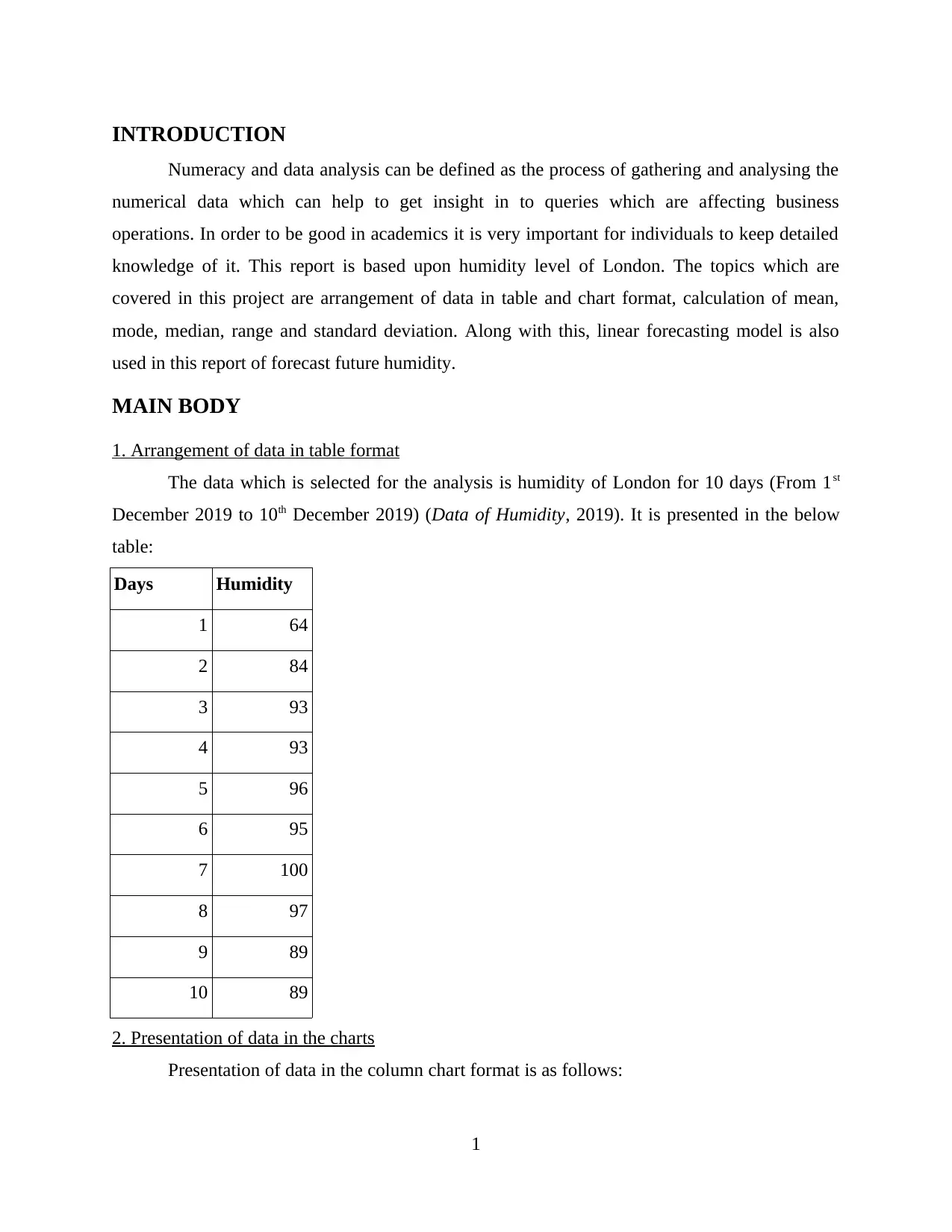
INTRODUCTION
Numeracy and data analysis can be defined as the process of gathering and analysing the
numerical data which can help to get insight in to queries which are affecting business
operations. In order to be good in academics it is very important for individuals to keep detailed
knowledge of it. This report is based upon humidity level of London. The topics which are
covered in this project are arrangement of data in table and chart format, calculation of mean,
mode, median, range and standard deviation. Along with this, linear forecasting model is also
used in this report of forecast future humidity.
MAIN BODY
1. Arrangement of data in table format
The data which is selected for the analysis is humidity of London for 10 days (From 1st
December 2019 to 10th December 2019) (Data of Humidity, 2019). It is presented in the below
table:
Days Humidity
1 64
2 84
3 93
4 93
5 96
6 95
7 100
8 97
9 89
10 89
2. Presentation of data in the charts
Presentation of data in the column chart format is as follows:
1
Numeracy and data analysis can be defined as the process of gathering and analysing the
numerical data which can help to get insight in to queries which are affecting business
operations. In order to be good in academics it is very important for individuals to keep detailed
knowledge of it. This report is based upon humidity level of London. The topics which are
covered in this project are arrangement of data in table and chart format, calculation of mean,
mode, median, range and standard deviation. Along with this, linear forecasting model is also
used in this report of forecast future humidity.
MAIN BODY
1. Arrangement of data in table format
The data which is selected for the analysis is humidity of London for 10 days (From 1st
December 2019 to 10th December 2019) (Data of Humidity, 2019). It is presented in the below
table:
Days Humidity
1 64
2 84
3 93
4 93
5 96
6 95
7 100
8 97
9 89
10 89
2. Presentation of data in the charts
Presentation of data in the column chart format is as follows:
1
⊘ This is a preview!⊘
Do you want full access?
Subscribe today to unlock all pages.

Trusted by 1+ million students worldwide
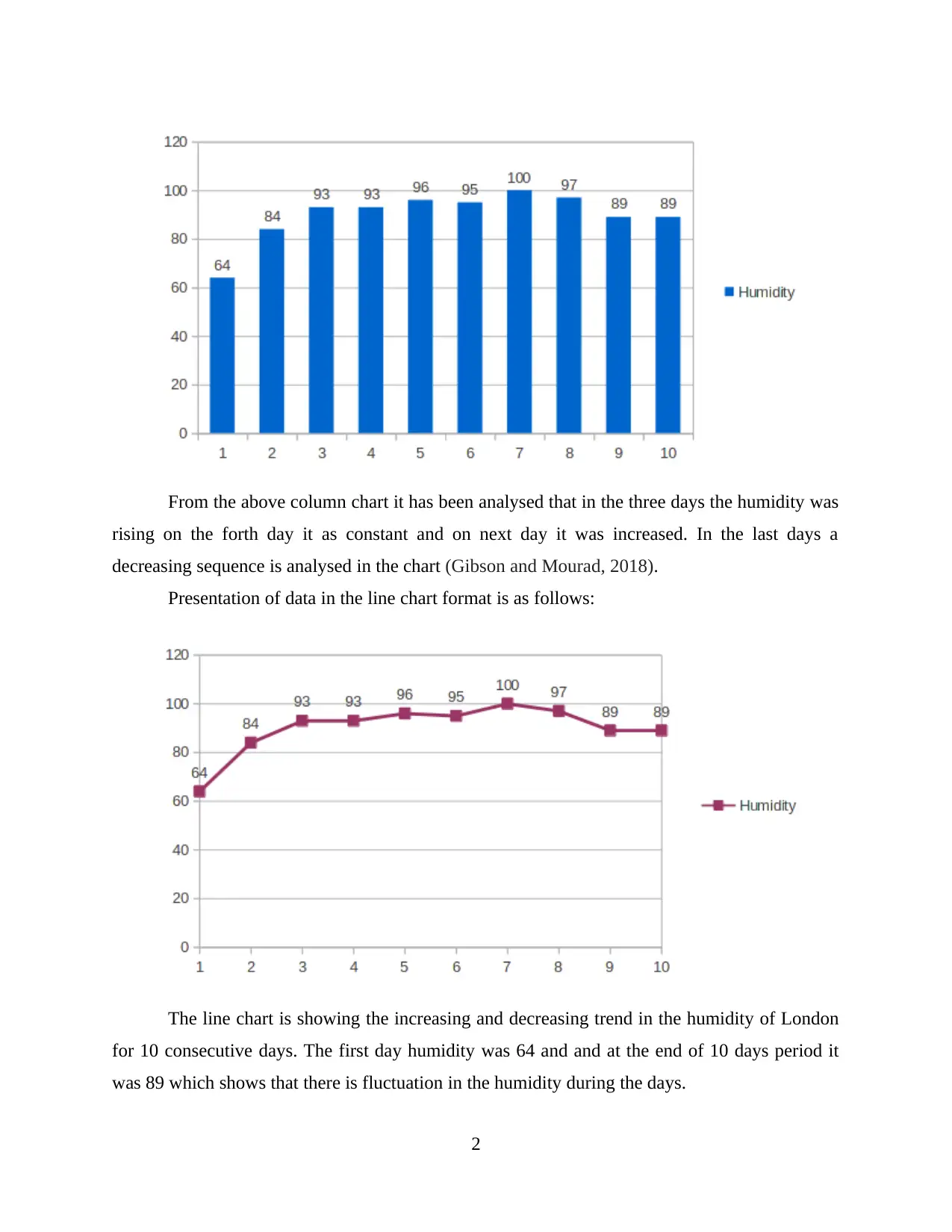
From the above column chart it has been analysed that in the three days the humidity was
rising on the forth day it as constant and on next day it was increased. In the last days a
decreasing sequence is analysed in the chart (Gibson and Mourad, 2018).
Presentation of data in the line chart format is as follows:
The line chart is showing the increasing and decreasing trend in the humidity of London
for 10 consecutive days. The first day humidity was 64 and and at the end of 10 days period it
was 89 which shows that there is fluctuation in the humidity during the days.
2
rising on the forth day it as constant and on next day it was increased. In the last days a
decreasing sequence is analysed in the chart (Gibson and Mourad, 2018).
Presentation of data in the line chart format is as follows:
The line chart is showing the increasing and decreasing trend in the humidity of London
for 10 consecutive days. The first day humidity was 64 and and at the end of 10 days period it
was 89 which shows that there is fluctuation in the humidity during the days.
2
Paraphrase This Document
Need a fresh take? Get an instant paraphrase of this document with our AI Paraphraser

3. Calculation of different elements with the help of steps and highlighting of final value
Days Humidity
1 64
2 84
3 93
4 93
5 96
6 95
7 100
8 97
9 89
10 89
Mean 90
Mode 89 & 93
Median 76.5
Range 36
Maximum 100
Minimum 64
Standard deviation 10
Mean: It can be defined as a value which is used in statistics for the purpose of showing
average of all the available values. Calculation of it along with the formula is as follows:
Formula - ∑X/N
= 900 / 10
= 90
3
Days Humidity
1 64
2 84
3 93
4 93
5 96
6 95
7 100
8 97
9 89
10 89
Mean 90
Mode 89 & 93
Median 76.5
Range 36
Maximum 100
Minimum 64
Standard deviation 10
Mean: It can be defined as a value which is used in statistics for the purpose of showing
average of all the available values. Calculation of it along with the formula is as follows:
Formula - ∑X/N
= 900 / 10
= 90
3
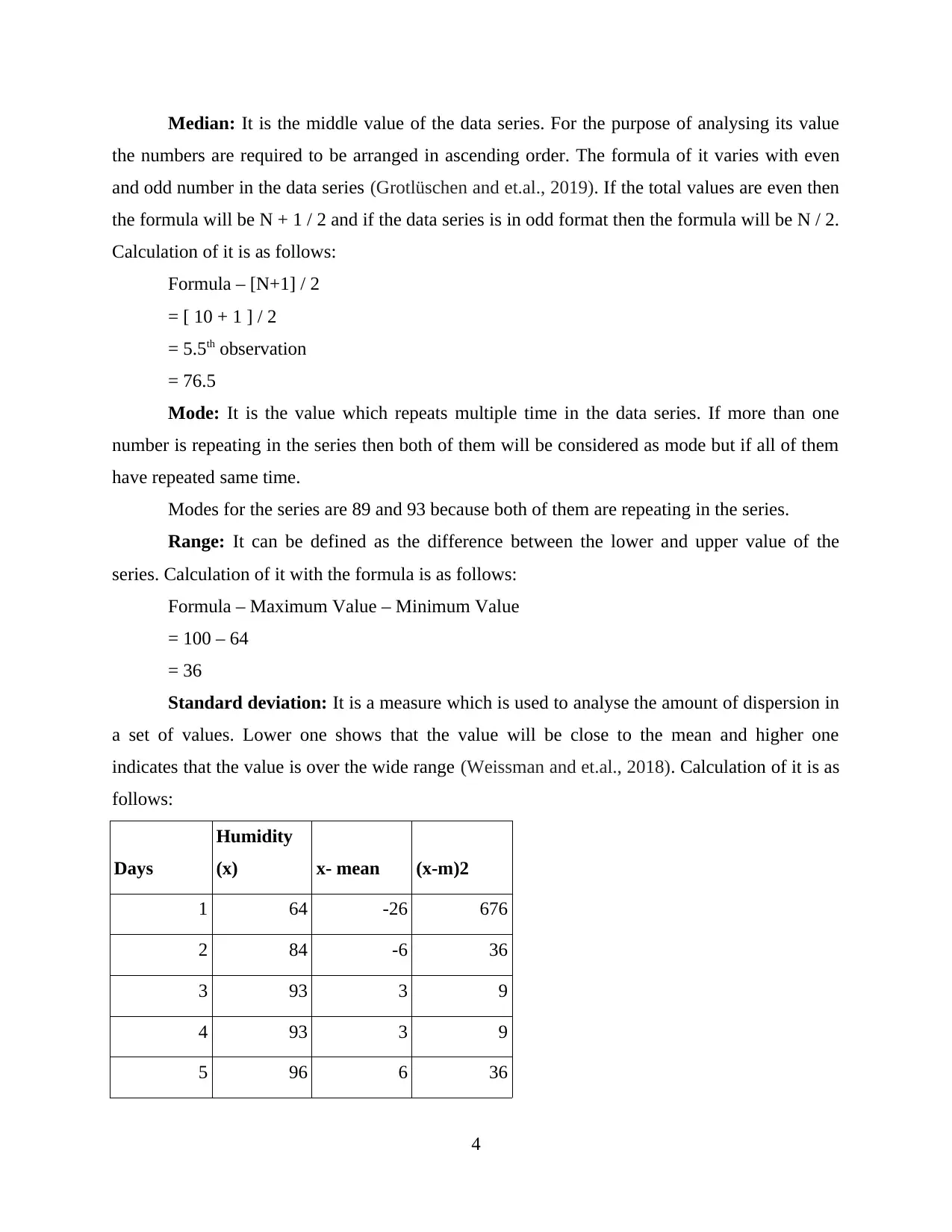
Median: It is the middle value of the data series. For the purpose of analysing its value
the numbers are required to be arranged in ascending order. The formula of it varies with even
and odd number in the data series (Grotlüschen and et.al., 2019). If the total values are even then
the formula will be N + 1 / 2 and if the data series is in odd format then the formula will be N / 2.
Calculation of it is as follows:
Formula – [N+1] / 2
= [ 10 + 1 ] / 2
= 5.5th observation
= 76.5
Mode: It is the value which repeats multiple time in the data series. If more than one
number is repeating in the series then both of them will be considered as mode but if all of them
have repeated same time.
Modes for the series are 89 and 93 because both of them are repeating in the series.
Range: It can be defined as the difference between the lower and upper value of the
series. Calculation of it with the formula is as follows:
Formula – Maximum Value – Minimum Value
= 100 – 64
= 36
Standard deviation: It is a measure which is used to analyse the amount of dispersion in
a set of values. Lower one shows that the value will be close to the mean and higher one
indicates that the value is over the wide range (Weissman and et.al., 2018). Calculation of it is as
follows:
Days
Humidity
(x) x- mean (x-m)2
1 64 -26 676
2 84 -6 36
3 93 3 9
4 93 3 9
5 96 6 36
4
the numbers are required to be arranged in ascending order. The formula of it varies with even
and odd number in the data series (Grotlüschen and et.al., 2019). If the total values are even then
the formula will be N + 1 / 2 and if the data series is in odd format then the formula will be N / 2.
Calculation of it is as follows:
Formula – [N+1] / 2
= [ 10 + 1 ] / 2
= 5.5th observation
= 76.5
Mode: It is the value which repeats multiple time in the data series. If more than one
number is repeating in the series then both of them will be considered as mode but if all of them
have repeated same time.
Modes for the series are 89 and 93 because both of them are repeating in the series.
Range: It can be defined as the difference between the lower and upper value of the
series. Calculation of it with the formula is as follows:
Formula – Maximum Value – Minimum Value
= 100 – 64
= 36
Standard deviation: It is a measure which is used to analyse the amount of dispersion in
a set of values. Lower one shows that the value will be close to the mean and higher one
indicates that the value is over the wide range (Weissman and et.al., 2018). Calculation of it is as
follows:
Days
Humidity
(x) x- mean (x-m)2
1 64 -26 676
2 84 -6 36
3 93 3 9
4 93 3 9
5 96 6 36
4
⊘ This is a preview!⊘
Do you want full access?
Subscribe today to unlock all pages.

Trusted by 1+ million students worldwide

6 95 5 25
7 100 10 100
8 97 7 49
9 89 -1 1
10 89 -1 1
Formula - √Variance
Formula of Variance = [ ∑ (x–mean)2/N ]
= 942 / 10
= 94.2 or 94
Standard deviation = √94
= 9.69 or 10
4. Use of linear forecasting model
While applying the liner forecasting model Days are considered as X and Humidity is
considered as Y (Budgen and West, 2018). The calculations for it is as follows:
Step 1: Table formulation
Days (X)
Humidity
(Y) X2 XY
1 64 1 64
2 84 4 168
3 93 9 279
4 93 16 372
5 96 25 480
6 95 36 570
7 100 49 700
8 97 64 776
9 89 81 801
5
7 100 10 100
8 97 7 49
9 89 -1 1
10 89 -1 1
Formula - √Variance
Formula of Variance = [ ∑ (x–mean)2/N ]
= 942 / 10
= 94.2 or 94
Standard deviation = √94
= 9.69 or 10
4. Use of linear forecasting model
While applying the liner forecasting model Days are considered as X and Humidity is
considered as Y (Budgen and West, 2018). The calculations for it is as follows:
Step 1: Table formulation
Days (X)
Humidity
(Y) X2 XY
1 64 1 64
2 84 4 168
3 93 9 279
4 93 16 372
5 96 25 480
6 95 36 570
7 100 49 700
8 97 64 776
9 89 81 801
5
Paraphrase This Document
Need a fresh take? Get an instant paraphrase of this document with our AI Paraphraser
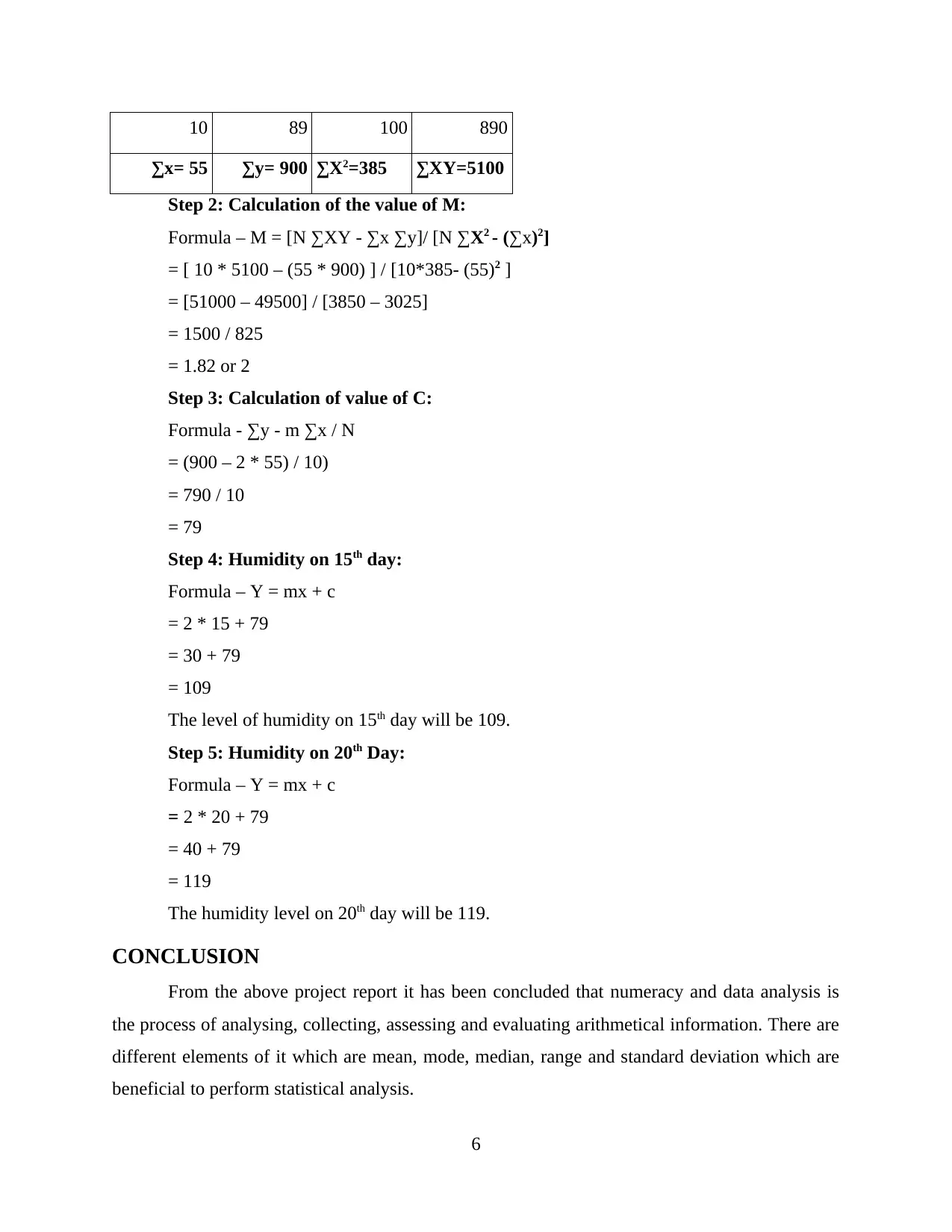
10 89 100 890
∑x= 55 ∑y= 900 ∑X2=385 ∑XY=5100
Step 2: Calculation of the value of M:
Formula – M = [N ∑XY - ∑x ∑y]/ [N ∑X2 - (∑x)2]
= [ 10 * 5100 – (55 * 900) ] / [10*385- (55)2 ]
= [51000 – 49500] / [3850 – 3025]
= 1500 / 825
= 1.82 or 2
Step 3: Calculation of value of C:
Formula - ∑y - m ∑x / N
= (900 – 2 * 55) / 10)
= 790 / 10
= 79
Step 4: Humidity on 15th day:
Formula – Y = mx + c
= 2 * 15 + 79
= 30 + 79
= 109
The level of humidity on 15th day will be 109.
Step 5: Humidity on 20th Day:
Formula – Y = mx + c
= 2 * 20 + 79
= 40 + 79
= 119
The humidity level on 20th day will be 119.
CONCLUSION
From the above project report it has been concluded that numeracy and data analysis is
the process of analysing, collecting, assessing and evaluating arithmetical information. There are
different elements of it which are mean, mode, median, range and standard deviation which are
beneficial to perform statistical analysis.
6
∑x= 55 ∑y= 900 ∑X2=385 ∑XY=5100
Step 2: Calculation of the value of M:
Formula – M = [N ∑XY - ∑x ∑y]/ [N ∑X2 - (∑x)2]
= [ 10 * 5100 – (55 * 900) ] / [10*385- (55)2 ]
= [51000 – 49500] / [3850 – 3025]
= 1500 / 825
= 1.82 or 2
Step 3: Calculation of value of C:
Formula - ∑y - m ∑x / N
= (900 – 2 * 55) / 10)
= 790 / 10
= 79
Step 4: Humidity on 15th day:
Formula – Y = mx + c
= 2 * 15 + 79
= 30 + 79
= 109
The level of humidity on 15th day will be 109.
Step 5: Humidity on 20th Day:
Formula – Y = mx + c
= 2 * 20 + 79
= 40 + 79
= 119
The humidity level on 20th day will be 119.
CONCLUSION
From the above project report it has been concluded that numeracy and data analysis is
the process of analysing, collecting, assessing and evaluating arithmetical information. There are
different elements of it which are mean, mode, median, range and standard deviation which are
beneficial to perform statistical analysis.
6
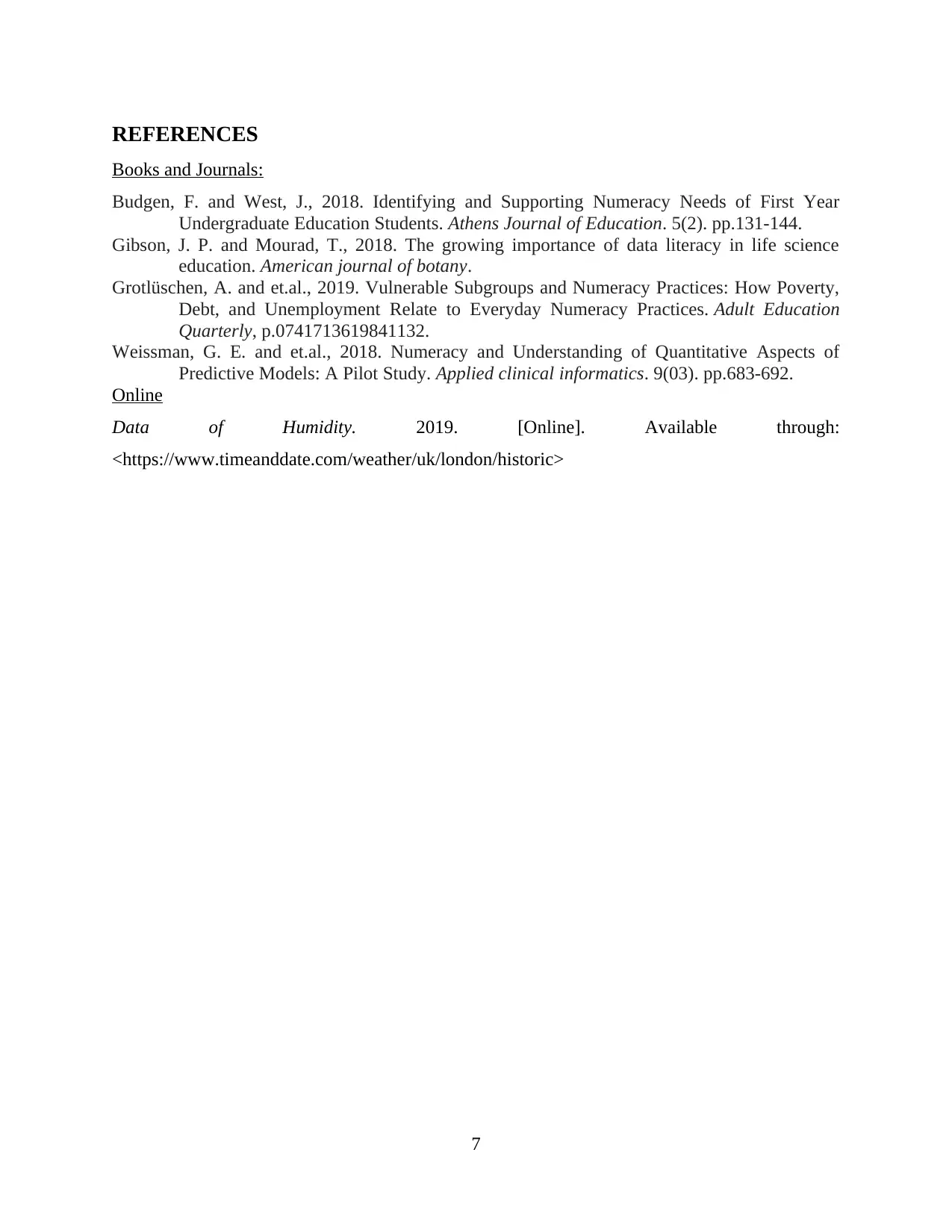
REFERENCES
Books and Journals:
Budgen, F. and West, J., 2018. Identifying and Supporting Numeracy Needs of First Year
Undergraduate Education Students. Athens Journal of Education. 5(2). pp.131-144.
Gibson, J. P. and Mourad, T., 2018. The growing importance of data literacy in life science
education. American journal of botany.
Grotlüschen, A. and et.al., 2019. Vulnerable Subgroups and Numeracy Practices: How Poverty,
Debt, and Unemployment Relate to Everyday Numeracy Practices. Adult Education
Quarterly, p.0741713619841132.
Weissman, G. E. and et.al., 2018. Numeracy and Understanding of Quantitative Aspects of
Predictive Models: A Pilot Study. Applied clinical informatics. 9(03). pp.683-692.
Online
Data of Humidity. 2019. [Online]. Available through:
<https://www.timeanddate.com/weather/uk/london/historic>
7
Books and Journals:
Budgen, F. and West, J., 2018. Identifying and Supporting Numeracy Needs of First Year
Undergraduate Education Students. Athens Journal of Education. 5(2). pp.131-144.
Gibson, J. P. and Mourad, T., 2018. The growing importance of data literacy in life science
education. American journal of botany.
Grotlüschen, A. and et.al., 2019. Vulnerable Subgroups and Numeracy Practices: How Poverty,
Debt, and Unemployment Relate to Everyday Numeracy Practices. Adult Education
Quarterly, p.0741713619841132.
Weissman, G. E. and et.al., 2018. Numeracy and Understanding of Quantitative Aspects of
Predictive Models: A Pilot Study. Applied clinical informatics. 9(03). pp.683-692.
Online
Data of Humidity. 2019. [Online]. Available through:
<https://www.timeanddate.com/weather/uk/london/historic>
7
⊘ This is a preview!⊘
Do you want full access?
Subscribe today to unlock all pages.

Trusted by 1+ million students worldwide
1 out of 9
Related Documents
Your All-in-One AI-Powered Toolkit for Academic Success.
+13062052269
info@desklib.com
Available 24*7 on WhatsApp / Email
![[object Object]](/_next/static/media/star-bottom.7253800d.svg)
Unlock your academic potential
© 2024 | Zucol Services PVT LTD | All rights reserved.




